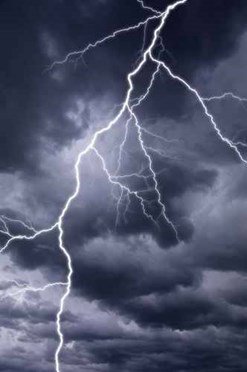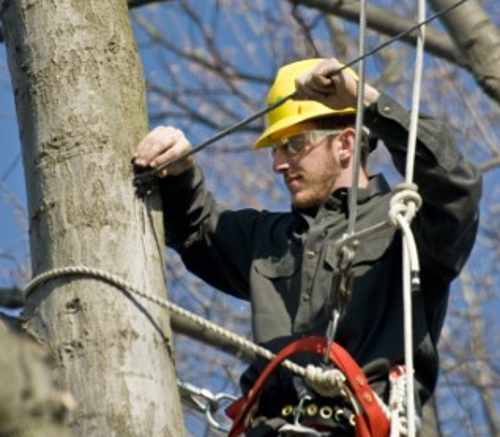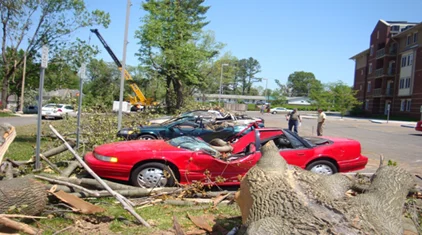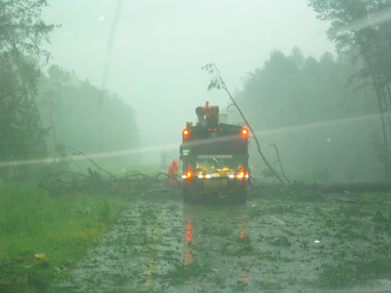
Storm preparation is a huge concern for citizens and communities. When a storm event occurs, trees and other woody debris are often one of the first things a community must deal with. Trees will fail and impact roadways, utility lines, street lights, intersections, homes, and people. Before power can be restored and primary responders can do their jobs, trees will need to be pruned, removed, and cleaned up. While it is impossible to be completely prepared for a storm incident, it is possible to be ready to react and minimize negative impacts from trees.
An urban forest is made up of both public and private trees - each a valuable part of the community’s infrastructure. Urban forests provide a host of environmental functions and services, from avoiding a stormwater runoff, reducing energy consumption, increasing property values, absorbing CO2, and improving the quality of life in a community. Unlike other components of a community’s infrastructure, trees and urban forests continue to appreciate in value as they age and get larger, therefore increasing environmental functions and services.
Within a community, there are two types of trees - those which are assets and others that are liabilities. Trees that are assets are the right tree planted in the right place for the right reasons and do not pose a high level of risk to the community. Trees that are liabilities pose an unacceptable level of risk to the community and do not provide an environmental function. Like any other community infrastructure, trees need maintenance and upkeep. Part of that maintenance plan should be storm preparation.
At the most basic level, an urban forest that is prepared for a storm event will be more resilient. This will save you time and money as well as provide a higher level of service to your residents.
Tree Risk Assessments

We can not make our trees 100% safe all of the time, but we can make them safer by conducting tree risk assessments. Tree risk assessments should be a component of every community’s Urban Forest Management Plan and should be performed by qualified personnel. There are three levels of tree risk assessment that correspond to the degree of inspection carried out.
- Level 1 inspection is a simple drive-by or walk-by “windshield” survey done annually.
- Level 2 is a 360° inspection taken from the ground level without the use of specialized equipment.
- Level 3 inspection is also 360° but involves specialized equipment like an aerial lift, drone, or Resistograph.
There are many types of tree risk assessment protocols used in the industry, but the most commonly accepted is the Best Management Practice (BMP) developed by the ISA. The ISA BMP methodology evaluates the likelihood of failure, the likelihood of impacting a target, and the consequences of the failure.
By conducting a regularly scheduled tree risk assessment of your urban forest, you can prioritize work that has been identified as posing the most risk. Trees that have the highest risk should be prioritized for needed maintenance such as removal, pruning, or cabling/bracing. Another possible option is to move the target like a picnic table or parked car.
Urban Forestry Storm Response & Recovery Plans

Including trees within a community’s storm and/or emergency response plans are highly recommended. As stated earlier, one of the first issues that need to be addressed when responding to a storm is clearing the streets and power lines from downed trees. Communication is key to ensuring that priority services are restored as soon as possible following a storm event.
The primary challenge from an urban forestry perspective with typical emergency response plans is that once the initial clean up is completed, there is still a large amount of debris and work that needs to be dealt with. A good Urban Forest Storm Response and Recovery Plan incorporate priority streets to open and remaining debris to manage. This often includes the use of temporary “marshaling yards,” renting specialized equipment like tub grinders, and bringing in contractors or using staff from other departments to help.
A tool that can be useful for predicting how much debris a storm may produce is i-Tree Storm. This free software, created by the USDA Forest Service, uses 2% random street segments to inventory trees less than 6” in diameter within 50 feet of either side of the right of way. By using i-Tree Storm, a community can better predict how much debris will need to be cleaned up following a storm and used immediately after a storm to measure how much debris needs to be cleaned up.
Elgin, IL Case Study
In fall 2007 Elgin, IL experienced two separate 70 mph wind events in a 24-hour period. This event generated 130+ calls and took three city tree crews and two contractor crews seven days to respond to the calls. In winter 2009 Elgin conducted a street and park tree inventory of its 60,000 trees and prioritized maintenance activities.
Utilizing the American Recovery and Reinvestment Act (ARRA) monies, they systematically implemented a risk reduction plan to remove 800 of the highest liability trees. In fall 2010, Elgin was struck by a very similar storm but as a result of their inventory and risk assessment work, they only received 32 calls, and two city crews were able to handle all the calls in less than 24 hours. The city received 100 fewer calls and saved 765 man hours by executing a proactive maintenance program.
Storm Response and Clean Up

The clean-up after a storm event can take anywhere from a couple of days to weeks and months depending on the severity of the storm and the condition of the urban forest. One of the first steps that a community should take once a storm has passed is to conduct a Level 1 Rapid Assessment. This windshield inventory should be done by a qualified arborist that can properly identify immediate high-risk trees. This assessment should be done on all public streets and properties that were affected by the storm.
If the storm is too large for your community to adequately respond, there is a high likelihood that FEMA will be deployed. The US Forest Service, in partnership with several state agencies, has also developed the Urban Forest Strike Team (UFST). UFST crews can be deployed immediately following a storm to assist communities in need that don’t have staff with urban forest management expertise to reduce unnecessary loss of urban tree canopy. The UFST was created because trees are often removed that could have recovered and hazardous trees that should have been removed were retained. The UFST can help avoid these types of mistakes.
Conclusion
Storms have the power to cause local and widespread devastation that will affect your urban tree canopy. Implementing proactive management strategies based on a current tree inventory will help to minimize damage and save your community time and money before a storm hits. Work to incorporate trees into the Emergency Response Plan or create an Urban Forest Storm Preparedness Plan to help your community respond to a storm event efficiently and effectively.



